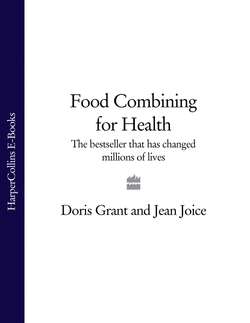Читать книгу Food Combining for Health: The bestseller that has changed millions of lives - Doris Grant - Страница 18
Constipation (Simple)
ОглавлениеFifty years ago William Howard Hay listed constipation as one of the main sources of acid formation in the system. He warned that long-term cases of constipation could be the cause of many of the degenerative diseases. Present-day medical findings have confirmed this warning and have also revealed that constipation is almost certainly a contributing factor to the high rate of bowel cancer in Western society.
Dr Hay also listed incompatible food combinations and fibre-deficient refined carbohydrates as sources of acid formation. Both these sources directly contribute to constipation. Striking proof that they do so was provided in a paper entitled ‘Amylaceous Dyspepsia’ (starch-caused indigestion), published in The Liverpool Medico-Chirurgical Journal in 1931. Its author was Dr Lionel J. Picton, author-in-chief of the famous Cheshire Medical Testament, published in 1938, in which 31 family doctors declared that the prevention of sickness depends on right feeding.
In this paper Dr Picton drew attention to a well-known laboratory experiment on dogs by the famous Russian scientist, Pavlov. From this experiment, according to Dr Picton, Pavlov deduced the following data: minced beef fed to a dog is digested in about four hours, starch by itself passed through a dog’s stomach in a much shorter time, in one-and-a-half hours or less, white bread more slowly than brown. But when meat was mixed with the starch there was invariably a delay – a protracted delay. Instead of four-and-a-half hours for meat alone, this mixture took eight or more hours to leave the stomach.
Dr Picton argued that this delay in one section of the line tended towards delay all along the line. As he pointed out: ‘The somewhat startling conclusion flows from this, that meals of mixed character such as meat and bread favour constipation, whereas meat and salad at one meal and starchy food such as bread and butter at a separate meal have no such effect.’
Dr Picton’s paper provided outstanding confirmation of the truth of the starch – protein concept, and of the close relationship of incompatible food mixtures to constipation. And his case histories of patients provided proof.
The first step in the treatment of constipation is therefore none other than that recommended by Dr Hay for all diseases, the removal of the cause – far too much acid-forming meat and carbohydrates (especially refined carbohydrates), far too little alkali-forming vegetables, salads and fruits, and incompatible food mixtures. Instructions for ‘the removal of the cause’ are given in Part Two; they are not difficult to follow and will soon prove to simplify meal-planning, and lessen cooking and the cost of cooking.
No matter how correctly the meals are combined, the fibre in the diet may be increased by taking unprocessed wheat bran daily. It should be taken at first in teaspoonful doses, in water, before meals, increasing this gradually to suit individual needs. The fibre found in oats, brown rice, linseeds or psyllium, vegetables and pulses is more soothing to the gut than wheat bran, which can cause problems for people with diverticulitis or irritable bowel syndrome. Linseeds or psyllium fibre are particularly helpful in encouraging regularlity and should always be taken with a large glass of water.
Neil S. Painter, well-known London surgeon, advises: ‘You are eating enough bran only when you can pass soft stools without straining. Once you have found this amount take it for life.’ Recent research has shown that in Westernized countries the daily stool is hard and viscous compared to that of rural Africans and Asians living on unrefined foods, and that the intestinal transit time (the time taken for food to traverse the intestines) may be as long as five days instead of 24 hours. Thus many people who think that they are not constipated may be very constipated indeed, despite having a daily stool. For this reason, and in order to speed recovery from any disease, Dr Hay suggested taking a daily two-quart, cool, plain water enema, but not without professional instruction.
